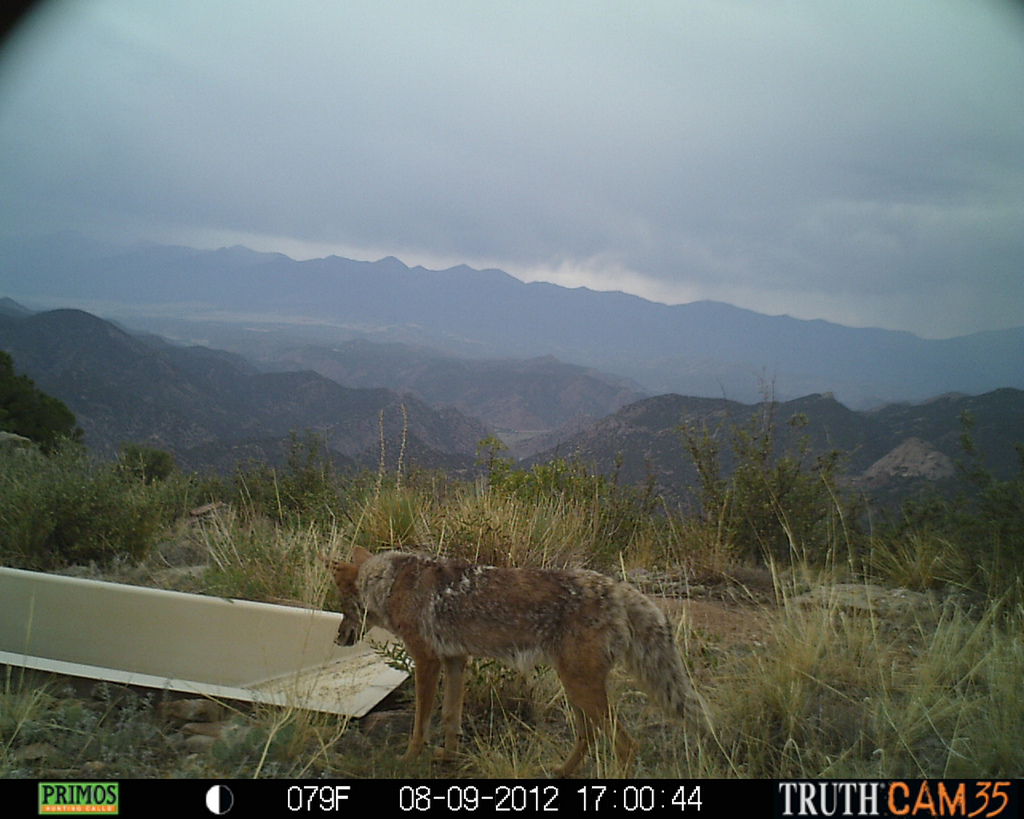
Carnivores in Our Midst: Should We Fear Them? (Op-Ed)

Marc Bekoff, emeritus professor at the University of Colorado, Boulder, is one of the world's pioneering cognitive ethologists, a Guggenheim Fellow, and co-founder with Jane Goodall of Ethologists for the Ethical Treatment of Animals. Bekoff's latest book is Why Dogs Hump and Bees Get Depressed (New World Library, 2013). This essay is adapted from one that appeared in Bekoff's column Animal Emotions in Psychology Today. He contributed this article to LiveScience's Expert Voices: Op-Ed & Insights.
The representation of nonhuman animals (animals) in media based on bad science or no science is bad for the animals — and it contributes to an unrelenting war on wildlife. Scientists need to be clear about what is known and what isn't about animals and their relations with people. Nonscientists rely heavily on mass media for disseminating such information, and even if it is not complete or accurate, people use it to form opinions about how animals should be treated if they become a "nuisance" or if they are perceived to be dangerous.
People kill "pests" far too frequently
Recently, I wrote an essay wondering if, as some claim, people are really killing animals we call "pests" too rarely, and I argued that indeed we're killing them far too frequently. I'm very concerned that incorrect representations of animals in mass media contribute to the situation, in part because of media's broad influence. People don't read about all of the friendly, or non-threatening encounters humans have with animals in their midst, but rather, when there is an attack or some sort of "aggressive" or "assertive" interaction, it makes the headlines.
In November 2012 I was surprised to see an essay by Jill Reillyin The Daily Mail (UK) titled "Wolves and mountain lions 'poised to invade densely populated cities in the United States'."
A number of people had written to me about the topic, so I thought it best to respond, which I did at the time stating that an "invasion" is simply not happening and the word "invade" is incredibly misleading and fear-provoking. A recent essay in Time magazine claiming people are too lenient on "pests," including carnivores who should be feared, made me think again about just how powerful and misleading media can be.
Reilly's essay on wolves and mountain lions began as follows: "Wolves and mountain lions could soon be a more common sight in densely populated cities in the United States, experts fear." Some experts fear would have been more correct, and as far as I know, they don't really fear the presence of these magnificent animals, they worry that if people begin to fear them the animals will lose. Well-respected coyote expert, Stan Gehrt, of Ohio State University, claims in the Reilly article that, "Thecoyote is the test case for other animals," including gray wolves and mountain lions (cougars). By test case, Gehrt is referring to the fact that predators are supposedly a widespread threat to human safety and how people respond to the presence of coyotes will influence how they feel about the presence of other predators who, in fact, are rather different from coyotes, and who only very rarely attack humans.
While some people may accept that sweeping claim, I believe it is highly questionable because coyotes have vastly different predatory habits and life styles than either wolves or mountain lions and solid science shows this to be the case. For extensive details on the fascinating lives of wolves please see the two excellent books"A New Era for Wolves and People: Wolf Recovery, Human Attitudes, and Policy" (2009, University of Calgary Press) and "The World of Wolves: New Perspectives on Ecology, Behaviour and Management" (2010, University of Calgary Press) edited by wolf experts Marco Musiani, Luigi Boitani and Paul Paquet, and for more information on mountain lions, check out the Cougar Fund.
What do available data show? First and most importantly, coyotes very rarely attack livestock. According to a U.S. Department of Agriculture report: Less than a quarter of one percent, 0.23 percent, of the American cattle inventory was lost to native carnivores and dogs in 2010. Domestic dog attacks and bites directed toward humans are incredibly more common and this is not surprising because there are many more dogs than coyotes in areas where people live.
Between 1960 and 2006 there were only 142 coyote attacks on 159 victims in the United States and Canada. It's estimated that between three and five people are attacked in the United States each year. To be sure, this is regrettable, but hardly something worth media hysterics.
Compare coyote attacks with attacks by domestic dogs. According to DogBiteLaw.com, in the United States, about 1,000 people a day are treated in emergency rooms for dog bites and in 2010 alone there were 34 fatal dog attacks. While these numbers might be difficult to compare because of the millions of dogs in close proximity to humans — in contrast to the comparably few coyotes who live around humans — it's clear that many more humans suffer from dog attacks than coyote attacks.
Burrito buffet: Coyotes have more opportunities to attack than they take
I have no doubt that coyotes have the opportunity to do significantly more harm than they do, but they choose not to do so. In areas where they are known to live — at least transiently — attacks have not been reported more often than in areas where they are only seen occasionally. In and around my hometown of Boulder, Colorado, the extremely rare confrontations between coyotes and humans have occurred where coyotes were known to be fed, either intentionally or unintentionally. One area was nicknamed the "burrito buffet" because these Mexican delicacies were found scattered all about. It's not surprising that animals are attracted to food and coyotes, like many other animals, are opportunists and have a very broad diet.
My own experience with coyotes and other urban animals is that they have a healthy respect for people and actually try to avoid humans most of the time. When I've asked colleagues about this impression, they all agreed. And, in some areas where coyotes are known to live fairly regularly, there have never been any reported confrontations.
When Canadian folksinger Taylor Mitchell was tragically killed by coyotes in October 2009, this was the first known fatal attack by coyotes on a human, and it still isn't clear what exactly happened. In a documentary about this horrific incident called "Killed by coyotes?," Gehrt claimed that the coyotes were motivated to kill and eat Mitchell. However, when I talked with other coyote experts along with my own take on this horrific incident, this simply cannot be known based on the reconstruction of the scene that was made public, and it would be very difficult to know if this were so even if someone saw what actually happened. Reconstructions of such incidents can be fraught with error. (Following the incident, Taylor's mother wrote a note of thanks for the support her family received and her remarks about how Taylor would not have wanted the coyotes to be killed.)
Who's afraid of the big bad coyote?
Gehrt has also claimed that "People living in urban areas are going to have to get used to predators on their doorstep." I frankly don't see how anyone can feel comfortable making this claim. Yes, predators eat other nonhuman animals, but because attacks on humans are incredibly rare, such a statement is far too sensational based on what we actually know about the behavior of these animals and the rarity of their encounters, serious and otherwise, with humans. Because he is a spokesperson for, and an expert on, urban coyotes whose research and writings I often consult, Gehrt needs to be clear about what is speculation and what is based on science. Speculation just adds fuel to the unrelenting war on wildlife — and the fable about never crying wolf comes to mind.
In fact, what researchers do know — and some of this is based on Gehrt's own laudable work — is that coyotes largely avoid people even in densely populated areas. They are not at our "doorstep" just waiting to attack or harass us. For example, studies discussed in Coyotes in Our Midst show they have shifted to a more nocturnal life in cities to avoid people. And, wolves and mountain lions don't live near enough to many "densely populated cities" to cause much concern and attacks. I don't know of any attack on a human by either a wild wolf or a wild mountain lion in an urban setting. Mountain lion attacks are incredibly rare, as noted by Marc Lallanilla in a previous essay for LiveScience, and there have only been two recorded fatal attacks on humans by wild wolves in North America and around two dozen nonfatal attacks in approximately the last 100 years.

Scientists also know that coyotes play an important role in helping to control rodents — among other free ecological services. As Camilla Fox of Project Coyote points out in her co-authored book "Coyotes in Our Midst," coyotes are smart, adaptable, resilient and deserving of respect and appreciation for the many ecological benefits they provide in both urban and rural areas (you can download a free copy of her book here). Let's appreciate America's song dogs for who they really are.
There's always a choice about where to live
There's always a choice about where to live (for people, not wildlife who are continually being displaced by humans) and how to coexist with other animals. Claims about how dangerous predators are and how people should fear them feeds into the hands of people who want to harm or kill the urban and other animals into whose homes people have moved. Having had many close encounters with the black bears and mountain lions living around my mountain home, who are very wary and try to avoid me and my few neighbors and keep a healthy distance between us unless someone leaves food around, I have a healthy respect for them. I've had to change my lifestyle, and that of my companion dogs, because of them, and I would never want them removed or harmed because of their presence on their home turf. If I don't like that they're around, I should have never moved into their living rooms, and I can always leave when I decide they've become "pests" or "too dangerous." It's clear that killing these animals doesn't work because others come in and fill the niche where they lived — I feel much more comfortable living with resident bears and cougars who know my and my neighbors' habits.
Media and scientists need to be clear about what we know and don't know, and we need to strive for peaceful coexistence with all the animals with whom we share our homes and into whose homes we have moved and redecorated. Humane education programs that focus on peaceful coexistence are on the rise across the United States, and both nonhumans and humans will benefit from these efforts.
Bekoff's most recent Op-Ed was "Have People Really Killed Pests Too Rarely?" This article was adapted from "Urban Carnivores: Are They As 'Bad'As Some Make Them Seem?" in Psychology Today. The views expressed are those of the author and do not necessarily reflect the views of the publisher. This version of the article was originally published on LiveScience.
Sign up for the Live Science daily newsletter now
Get the world’s most fascinating discoveries delivered straight to your inbox.
Why is yawning contagious?
Scientific consensus shows race is a human invention, not biological reality










